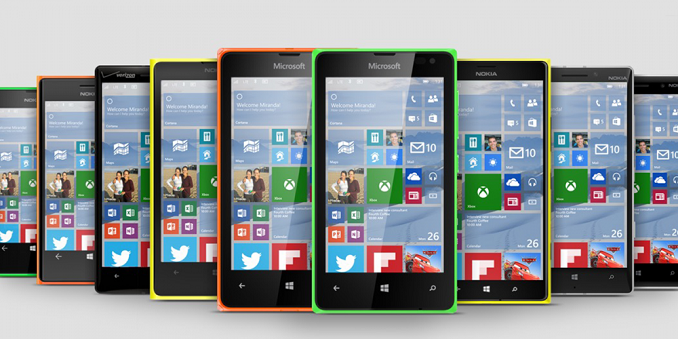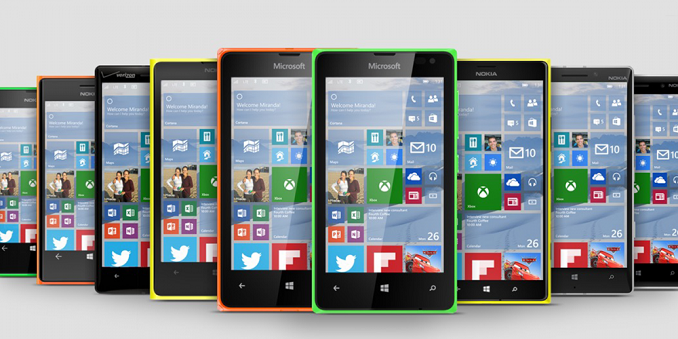Windows 10 Technical Preview For Phones Now Available
Today Gabe Aul (@GabeAul), who runs the Windows Insider program, announced on the Windows Blog that the Windows 10 Technical Preview for Phones is now available to people who have joined the Windows Insider Program. It brings a lot of changes to the phone, and really maps phone features to those already available on the Windows 10 Technical Preview on the PC. For those that have followed Windows Phone over the years, you may be aware that there was an existing preview program called Preview for Developers. The Preview for Developers was a way for Microsoft to work around the slower update cycle for Wireless Phone providers so that the development community could start programing to the newest APIs right away. Since it was free to join, non-developers could also leverage if to gain access to quicker updates.
The new update program is quite a bit different than Preview for Developers. This will be the earliest publicly available preview for the phone OS yet. Preview for Developers would give access to non-beta versions of Windows Phone, and the Windows Insider Program is certainly pre-release software, complete with bug lists and missing features. The build launched today is far from feature complete, and over time, updates will come to both the PC and phone to improve features, fix bugs, and polish the experience.
This is now Windows 10 on the phone, and it brings with it the universal apps which already are available on the Windows 10 Technical Preview for the PC, but with a phone sized UI.
Some of the features available in today’s build include:
Full-size background image on the start screen. In Windows Phone 8.1, the ability to set a photo as a background, and it would show through certain tiles. Only tiles with the ability to be made the system color would show through, and tiles that had their own theme would be opaque. You can see this in our Windows Phone 8.1 review. For Windows 10, the background image is actually on the background now, and also shows through the tiles. This replaces the black background on Windows Phone with the image, and keeps the tiles semi-transparent to see the image through them.
Windows Phone 8.1 also added the Action Center, and that has carried on to Windows 10 on both the PC and the phone. On the phone, the number of quick action buttons, which allow you to do things like toggle Wi-Fi or Bluetooth, were fully customizable but limited to 4 or 5 depending on the screen size. For Windows 10, the Action Center now offers an expanded view, allowing many more quick actions to be available. This is a nice continuation of the Desktop version which has the same expandable capability.
One feature that I am very excited to see is the interactive notifications. On Windows Phone, if you got a text message (as an example) a “toast” would pop down on the top of the screen to let you know. Now, with Windows 10, the toast is now actionable, and you can reply in-line with the toast rather than having to switch to the Messaging app. Windows is certainly not the first OS to allow this, but it is a nice feature and I am very glad to see it being added.
The Photos app gets a major update. With the latest Windows 10 Preview build made available in January, the Photos app was very much re-written as a universal app. The Windows 8 and 8.1 version of the photos app was not very good at all, so this new version corrects a lot of issues with it. Due to the focus on Microsoft using universal apps, the phone will now have the exact same app available to it as well.
You can also use text to speech on practically any text input field now too, using the excellent text to speech capabilities introduced with Cortana to map your voice to include punctuation and the correct homophones based on the context.
There are a lot of other features as well, including the new universal app for Settings, which will hopefully fix the issue in Windows Phone since day one where the settings are not in any sort of order, and cannot be sorted.
Joe Belfiore of Microsoft made a YouTube video showing off some of the new capabilities:
Being that this is a very early build, if you do want to install it, be aware that there are quite a few known issues, including Cortana only being available in the US and with English, even though Windows Phone 8.1 has support for Cortana in quite a few more regions and languages. These will be added over time. There are a lot of other known issues with the current build as well, so if you are interested in trying this out, please read the source listed at the bottom of the article to get a full listing. Many of these have workarounds listed.
However, if you do want to participate today, there is some bad news. The preview is limited to a very small selection of phones due to the initial phone OS partition size. Microsoft will be adding a partition stitching capability to Windows 10 in the future to allow updates on the devices with less space available for the OS partition, but this really limits the devices available now to:
- Lumia 630
- Lumia 635
- Lumia 636 (China variant)
- Lumia 638 (India variant)
- Lumia 730
- Lumia 830
I have quite a few Windows Phones here, however I do not have a single one of these available, so a more in-depth look at the phone update will have to wait until they add more devices to the mix.
One good thing to note though is that the Lumia 630 and Lumia 635 are both 512 MB devices, so those with less RAM will not be excluded from Windows 10 as some rumours seemed to suggest.
For those that want to take the plunge, and have one of the eligible devices, make sure you sign up to the Windows Insider Program and then download the Windows Insider app to get access to the builds.
Source: Windows Blog





